Solar eclipse 2024: Photos, videos from across the US
It's eclipse day! The much-anticipated "Great North American" eclipse of 2024 is finally here.
Millions of Americans flocked to the 115-mile wide stretch of the U.S. known as the "path of totality" – from Texas to Maine – where daytime briefly turned to darkness as the moon completely blocks the sun. It's the first time the U.S. has had a full solar eclipse since 2017.
You can watch live eclipse coverage all day long on LiveNow from FOX in the video player above. Here are some other highlights from the big event.
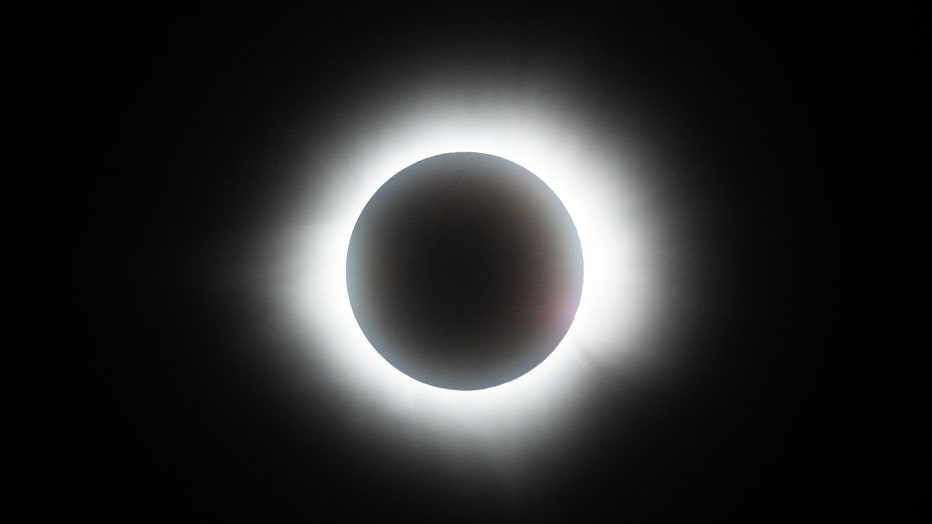
The sun disappears behind the moon during the Great North American Eclipse on April 08, 2024 in Mazatlan, Mexico. (Photo by Hector Vivas/Getty Images)
RELATED: 2024 eclipse: See photos of the celestial event
4:10 pm ET: What to do with your eclipse glasses
According to NASA and other experts, there are a few options.
Save them: If your eclipse glasses are compliant with the ISO 12312-2 safety standard, NASA said you may look at the uneclipsed or partially eclipsed sun through them for as long as you wish.
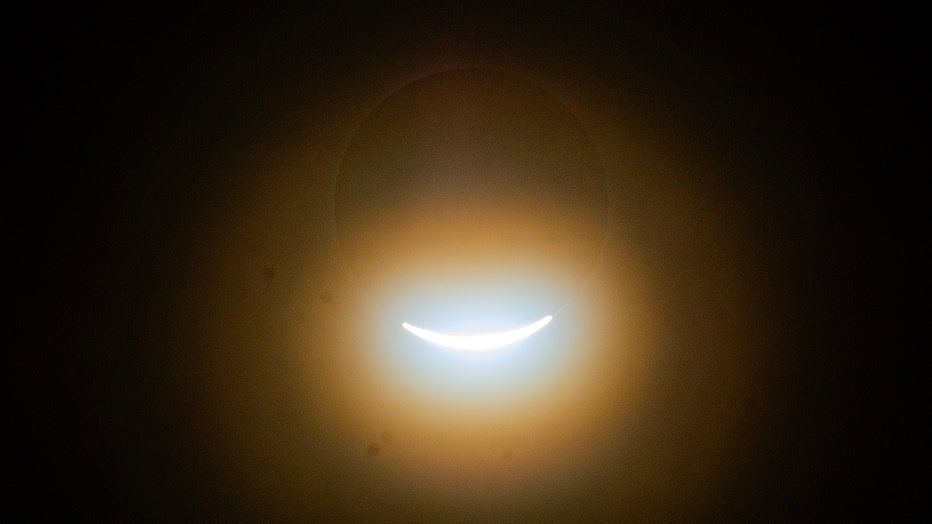
Seconds after the end of totality, seen from Hudson, Ohio. (Chris Boex / FOX photo)
Recycle them: According to Earth911.com, you can also choose to recycle your eclipse glasses by removing the protective solar-filter lenses and tossing paper frames into a recycling bin.
You’ll likely need to toss out your solar-filter lenses, but the frames are usually paper or cardboard, so they’re likely acceptable with other paper recyclables.
Donate them: You can also consider donating your glasses to Astronomers Without Borders (AWB), a non-profit organization running its second nationwide eclipse glasses recycling drive.
The group collected tens of thousands of glasses for distribution in South America, Asia and Africa after the 2017 Great American Total Solar Eclipse.
RELATED: I looked at the eclipse without glasses; now what?
3:40 pm ET: Totality in Rochester obscured by cloud cover, spectacular show in Maine
Clouds covered some of the total solar eclipse as it moved over parts of New York, but the clear skies in Maine made watching the eclipse an unforgettable experience. FOX Weather storm tracker Mark Sudduth was brought to tears:
3:15 pm ET: Totality in Indiana
Solar eclipse: Totality arrives in Indianapolis
The crowd went wild as day turned to night at Indianapolis Motor Speedway for the total solar eclipse.
2:45 pm ET: Totality in Texas
The eclipse reached totality in Dallas, Texas, around 1:45 p.m. Central time.
Total eclipse 2024: Totality in Austin
Watch the moment the skies turned dark for eclipse-watchers in Austin, Texas.
2:15 pm ET: Nearing totality in Texas
Kerrville, Texas, is among the first American cities to see totality. They will see totality just after 1:30 p.m. Central time. Totality will reach Dallas around 1:45 p.m.
Watch the solar eclipse begin in Texas
Watch live as the 2024 total solar eclipse begins to reach peak totality near Dallas, Texas and Mexico.
1:50 pm ET: Nearing totality in Mexico
Parts of Mexico's Pacific coast will see the moon completely block the sun – known as totality – shortly after 11 a.m. Pacific time. Here's what it looked like leading up to the big event:
Solar eclipse: Nearing totality in Mexico
This is what the sun looked like in Mexico moments before the moon completely blocks the sun during the total solar eclipse.
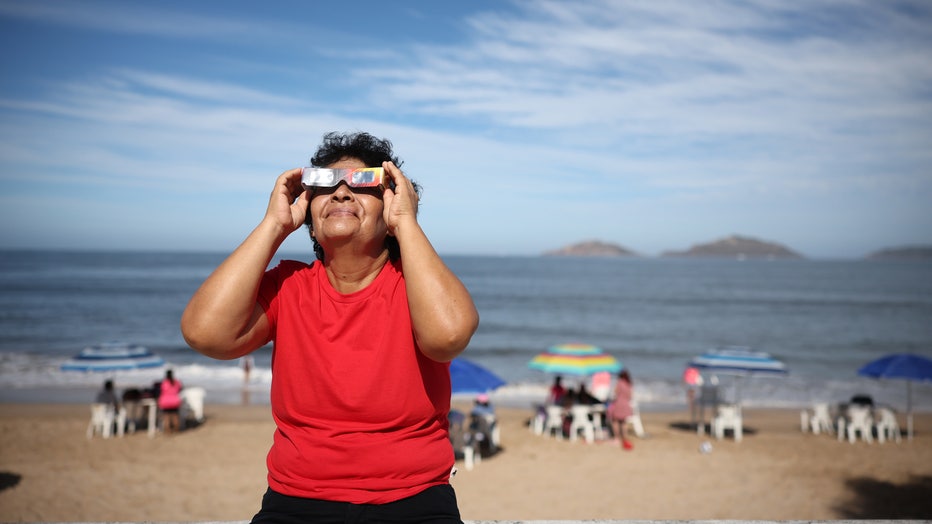
A woman puts on her glasses to see the eclipse on April 08, 2024 in Mazatlan, Mexico. (Photo by Hector Vivas/Getty Images)
1:15 pm ET: Partial eclipse begins in Texas, Mexico
Solar Eclipse 2024: Countdown to totality
Elizabeth Carey is live in Buffalo, NY with a live report ahead of the 2024 Solar Eclipse. Watch LiveNOW from FOX for special coverage of the eclipse.
A partial eclipse has started for parts of Texas at 12:10 p.m. CT and is already underway in Mexico, FOX Weather reports.
1 pm ET: Solar eclipse glasses sold on Amazon, in stores recalled
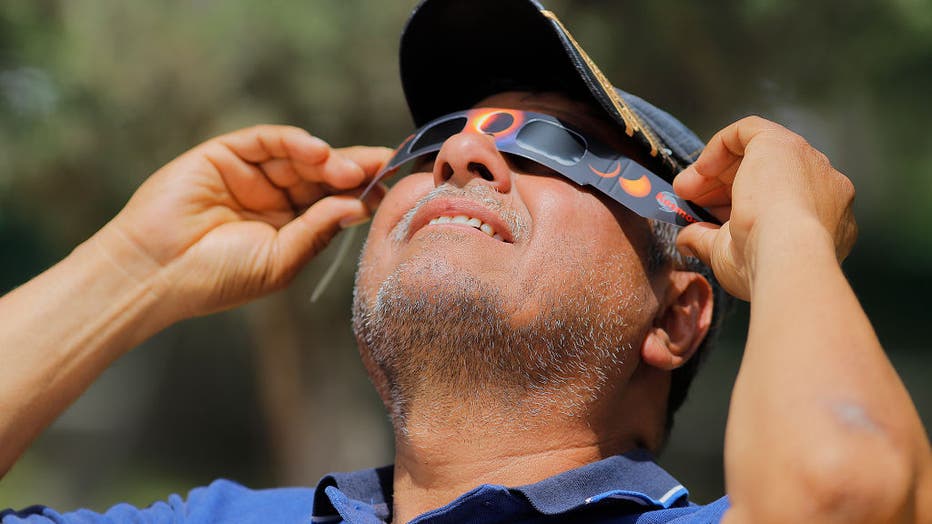
A man wears special glasses to observe the Great North American Eclipse ahead of tomorrows eclipse on April 7, 2024 in Torreon, Mexico. (Photo by Manuel Guadarrama/Getty Images)
Certain solar eclipse glasses brands sold on Amazon and at stores have been recalled. The recalled glasses were reportedly sold through Amazon as Biniki Solar Eclipse Glasses AAS Approved 2024 – CE & ISO Certified Safe Shades for Direct Sun Viewing (6 Packs), according to the Illinois Department of Health.
The recalled glasses are labeled as "EN ISO 12312-1:2022"; proper safety glasses should carry the ISO designation of 12312-2.
12:30 pm ET: New Yorkers line up around the block for eclipse glasses
New Yorkers ready for total solar eclipse
FOX Weather's Brandy Campbell joins LiveNOW's Andy Mac as she speaks to Rochester, New York residents ahead of Monday's total solar eclipse.
Millions of people in NYC are gearing up for up to 90% coverage during the solar eclipse. It won't be a total solar eclipse in New York, but people are planning for one anyway.
Lines for eclipse glasses were wrapped around city blocks; other vendors pulled up and started selling eclipse glasses out of trucks, according to social media reports.
The eclipse in NYC is set to start at 2:10 p.m., lasting until 4:36 p.m., for a total of two hours and 26 minutes. The best time to see the partial eclipse in New York City is at 3:25 p.m.
12 pm ET: Traffic jams begin along path of totality
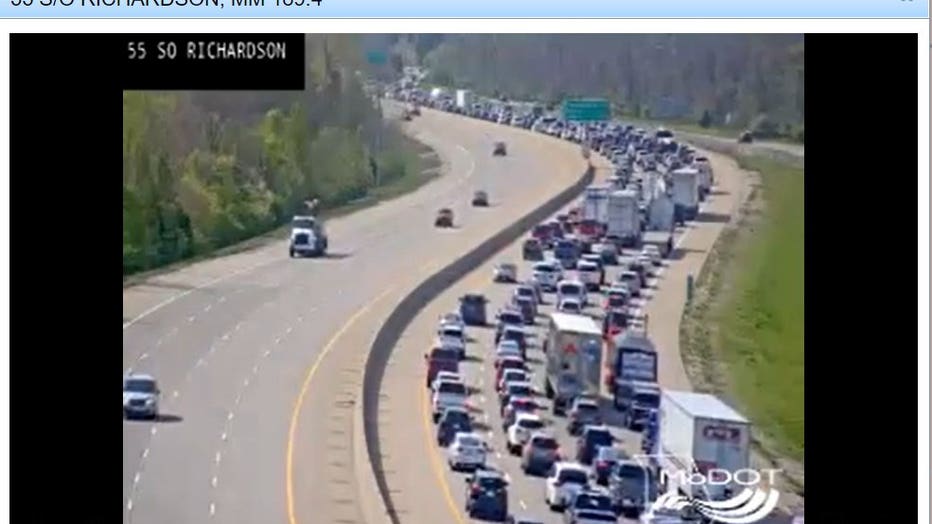
Traffic is backed up for 25 miles along I-55 in Missouri ahead of the total solar eclipse (Missouri Department of Transportation)
If you haven't left for your final eclipse viewing destination, you should probably do so soon, or you may end up stuck on the highway during the big event.
Traffic cams in Missouri, New York, Ohio and Texas are showing congestion hours ahead of the eclipse's peak.
RELATED: Safety tips for driving during the eclipse
The Missouri Department of Transportation said there was a 25-mile backup on I-55 in St. Louis County as of 10:30 a.m. local time.
11:30 am ET: Couples to marry in mass wedding at Total Eclipse of the Heart Fest
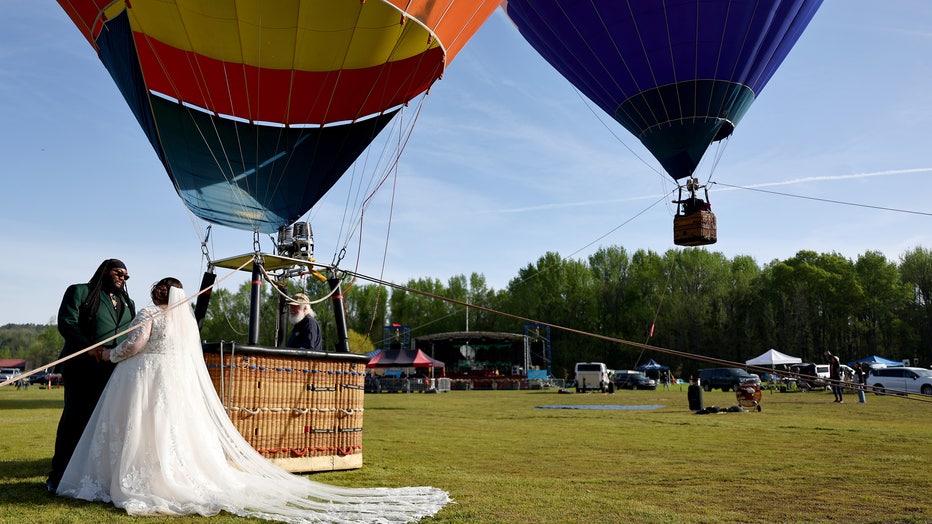
Bride and groom Kylee and Michael Rice prepare to take a hot air balloon ride before a planned mass wedding of over 200 couples at the Total Eclipse of the Heart festival on April 8, 2024 in Russellville, Arkansas. (Photo by Mario Tama/Getty Images)
The Total Eclipse of the Heart Festival in Russellville, Arkansas continues for a third day today – and culminates with a mass wedding where up to 200 couples will get married all at the same time in an event dubbed Elope at the Eclipse.
Couples who plan to get married at the festival today are able to take hot air balloon rides before and after the eclipse. The festival also includes live music.
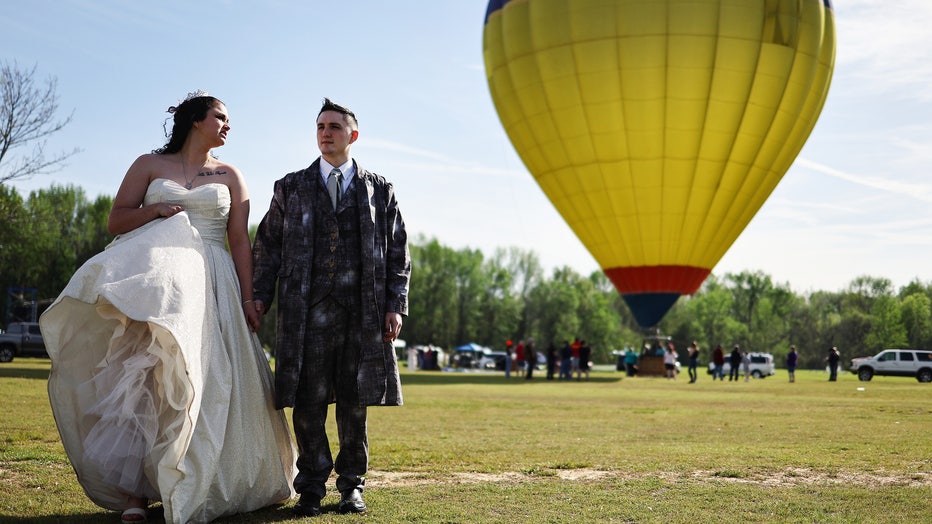
Bride Toni Phillips and groom David Wells look on before a planned mass wedding of over 200 couples at the Total Eclipse of the Heart festival on April 8, 2024 in Russellville, Arkansas. (Photo by Mario Tama/Getty Images)
11 am ET: Texas Eclipse Festival canceled due to severe weather threat
The Texas Eclipse Festival in Burnet has been canceled because of the threat of severe weather.
"Your safety is our top priority," festival organizers said. "With the support and coordination of Burnet County officials, local safety agencies and the National Weather Service, we’ve agreed to end the festival today in a calm orderly manner."
10:30 am ET: NASA animation shows eclipse totality
NASA released a neat animation Monday showing exactly how the eclipse will travel across the U.S. Check it out:
Neat NASA visualization shows eclipse path
A cool new animated graphic from NASA shows exactly how the eclipse will travel across the US.
10 am ET: What to know about pets and solar eclipse
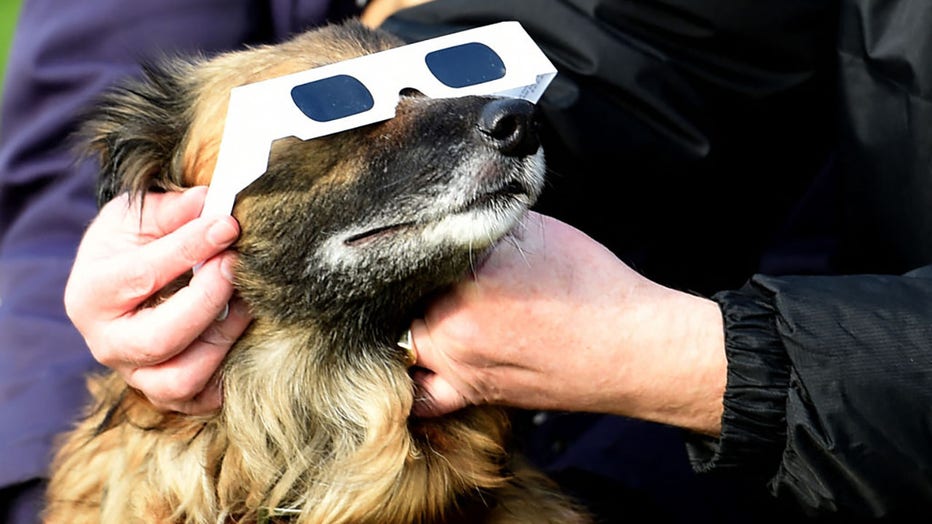
FILE - People use protective glasses on their dog during a partial solar eclipse at the Pier Head in Liverpool, north-west England, on March 20, 2015. (Photo by PAUL ELLIS/AFP via Getty Images)
While some abnormal animal behavior has been recorded during eclipses of the past, don’t expect anything unusual from your pets.
However, there are a few things you can do to make sure they’ll stay safe – including leaving pets inside during the eclipse (but not for any reason that has to do with the sun).
"Though one could take pets outside for an eclipse, they really won’t appreciate the phenomenon, and you probably should not take them if there are going to be many people or crowds present, which could cause fear or anxiety to certain pets," Dr. Jerry Klein, the Chief Veterinarian with the American Kennel Club, told FOX Television Stations.
"The concern is that they may stress and try to escape, so always make sure pets are properly controlled, on leashes," he added.
9:45 am ET: How to get the best view of the solar eclipse
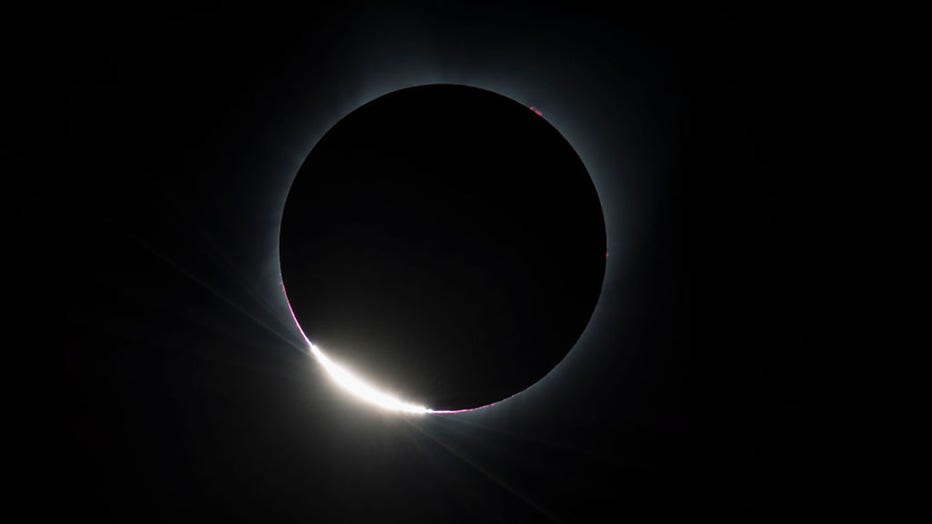
The Diamond Ring effect is seen as the moon makes its final move over the sun during the total solar eclipse on Monday, August 21, 2017 above Madras, Oregon. (Photo by: HUM Images/Universal Images Group via Getty Images)
It may seem as simple as walking outside and looking up.
But in order to get the clearest possible view of the sky, there are some ways to plan ahead.
9:30 am ET: Crowds gather at Niagara Falls ahead of solar eclipse
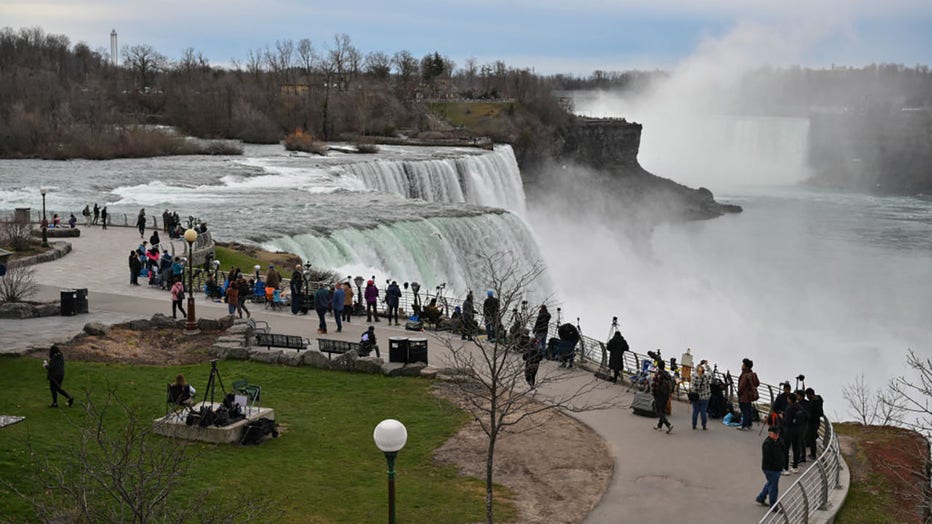
People gather at Niagara Falls State Park ahead of a total solar eclipse across North America, in Niagara Falls, New York, on April 8, 2024. (Photo by ANGELA WEISS/AFP via Getty Images)
People have started gathering at Niagara Falls in New York ahead of the total solar eclipse on Monday afternoon.
This year's path of totality is 115 miles wide, stretching from southern Texas up through Ohio, then over to northern Maine.
The next total solar eclipse visible from a large part of North America won't be until 2044.
9 am ET: How to make sure your eclipse glasses work

A man wears special glasses to observe the Great North American Eclipse ahead of tomorrows eclipse on April 7, 2024 in Torreon, Mexico. (Photo by Manuel Guadarrama/Getty Images)
It’s not safe to look directly at the sun without proper eye protection. In fact, the only time it’s safe to do so is during the brief period when the moon completely blocks the sun.
Looking at the sun through a camera lens, binoculars, or any other type of lens without a special solar filter will also injure your eyes.
NASA says before you take your eclipse glasses out to the main event, do these checks to make sure they’re safe to use.
8:50 am ET: 125,000 visitors expected in Indianapolis
FOX Weather Correspondent Robert Ray spoke with Visit Indy Senior Director of Public Relations Morgan Snyder who said it’s possible that 125,000 people may be visiting Indianapolis for the total solar eclipse on Monday.
Indianapolis is among the cities that have been planning for the eclipse for months, ready to capitalize on the tourism boom.
Beyond simply visiting cities in the path of totality, here are 16 of the coolest ways to watch the celestial event.
8:45 am ET: Major cities in path of totality face dangerous severe weather threat
NOAA's Storm Prediction Center has placed more than 5 million people in a Level 3 out of 5 risk, including some cities along the western edge of the path of totality in Texas, such as Dallas, on its 5-point severe thunderstorm risk scale.
But more than 10 million people are in a Level 2 out of 5 risk, which includes several other cities along the path of totality, such as San Antonio, Austin, Waco and Texarkana, according to FOX Weather.
Little Rock, Arkansas, is also at risk of seeing severe weather on Monday, but the severe weather risk there is slightly lower, meteorologists say.
8 am ET: Do not stop on roads, highways during eclipse, Dallas police say
The Dallas Police Department is reminding people not to stop on highways or roads to watch the solar eclipse. Drivers should also prepare and plan for travel delays.
7:45 am ET: How the total solar eclipse boosts the economy
As millions prepare to see the rare total solar eclipse in different cities across North America, it also brings an added benefit.
LiveNOW from FOX host Jeane Franseen spoke to consumer strategist Lisa Miller about how the eclipse will boost the economy.
How the total solar eclipse boosts the economy
The total solar eclipse is expected to take place today as many all over the world are preparing. LiveNOW from FOX host Jeane Franseen spoke to Consumer Strategist, Lisa Miller about how the eclipse will boost the economy.
RELATED: How much are you spending for the eclipse? Here’s what Americans are saying
7:30 am ET: Solar eclipse 2024 food deals and freebies

Insomnia Cookies' limited-edition Moon Cookie Cake
The rare total solar eclipse is happening today, dimming skies across a generous path of North America, and businesses are celebrating the celestial event with food deals and freebies.
From a "blackout" float to special doughnut treats and Moon Pies, here are some blindingly good treats to enjoy for the special day.
6:30 am ET: Total solar eclipse forecast shows where clouds could interfere
Monday morning solar eclipse 2024 forecast
FOX Weather meteorologists share the latest outlook on viewing conditions for different areas in the path of totality.
America's Total Eclipse is happening today. Here's the latest outlook from the FOX Forecast Center showing which regions of the U.S. will have the best viewing conditions and which areas might have to contend with cloud cover.
4:45 am ET: NWS releases details on expected cloud cover in New York
The National Weather Service office in Albany, New York, released some information about what they're expecting in terms of cloud cover for the solar eclipse this afternoon.
Check out a more detailed look at the total solar eclipse forecast.
What to know about the April 2024 solar eclipse

Projected path and time of totality for the 2024 total solar eclipse over the U.S.
The April 2024 solar eclipse will be visible, at least in part, to nearly everyone in the U.S. But the path of totality – where the moon will completely block the sun – is a 115-mile-wide region that stretches from southern Texas up through Ohio, then over to northern Maine.
Southern Texas will see the peak of totality first, around 1:30 p.m. Central Daylight Time. Then Dallas at 1:42 p.m., with the time getting later and later as the moon’s shadow moves north. Indianapolis will see the peak around 3:05 p.m. Eastern Daylight Time; Cleveland at 3:15 p.m., and northern Maine around 3:30 p.m.
However, it will take several hours for the moon to move across the sun, so the actual eclipse event will start just over an hour before the peak of totality, with more and more of the sun slowly being blocked.
Large cities in the path of totality include:
- Austin, Texas
- Dallas, Texas
- Little Rock, Arkansas
- Carbondale, Illinois
- Indianapolis, Indiana
- Cleveland, Ohio
- Buffalo, New York
- Plattsburgh, New York
- Presque Isle, Maine
The farther you are from that path, less and less of the sun will appear to be blocked. Those closest to the center of the path will see total darkness for about four minutes at the peak of totality.
But because the moon moves slowly across the sun’s path, the entire eclipse event – from when the moon first clips the sun until the time it clears – will last from 90 minutes to over two hours for those in the path of totality.
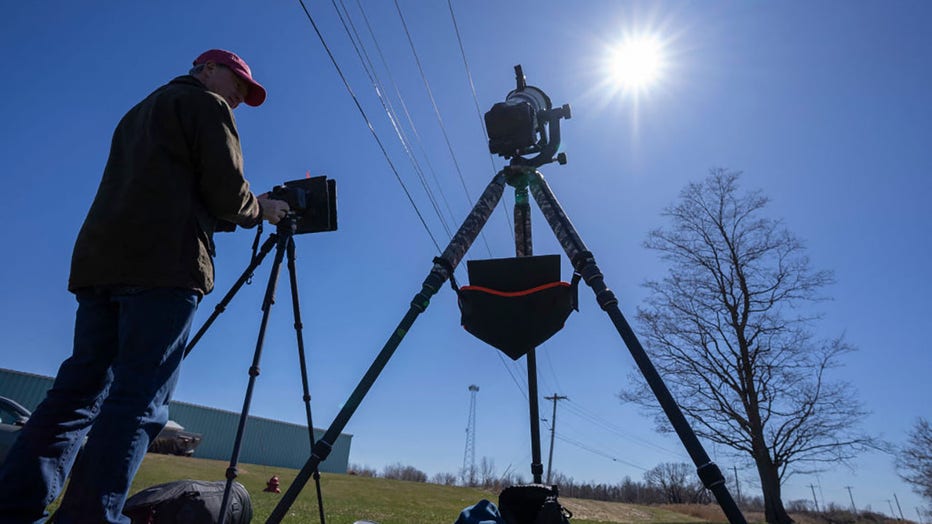
John Bills tests his camera equipment on the eve of a total solar eclipse across North America, in Cape Vincent, New York, on April 7, 2024. (Photo by STAN HONDA/AFP via Getty Images)
After 2024, NASA says, the next total solar eclipse visible from any point in the contiguous United States will occur in 2044. Totality will only be visible from North Dakota and Montana.
The next total solar eclipse that will travel across the lower 48 states from coast to coast is in 2045.

